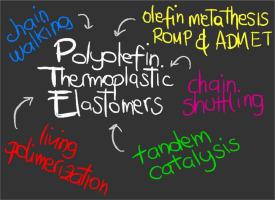Progress in Polymer Science ( IF 26.0 ) Pub Date : 2020-12-17 , DOI: 10.1016/j.progpolymsci.2020.101342 Giorgia Zanchin , Giuseppe Leone

|
Polyolefins have dominated materials technology over the last century and remain among the most used materials, despite environmental problems have emerged and their public perception deteriorated. Polyolefin thermoplastic elastomers (P-TPEs) are a particular class of polyolefins: they can be easily molded and extruded like thermoplastics, featuring at the same time elastic properties. P-TPE advantages over thermoset rubbers are their mechanical flexibility, lightweight, easy processability, and recyclability, fulfilling the requirements for a sustainable circular economy of the next plastic generation. This review describes the recent developments based on a historical account and summarize major breakthroughs with the focus on P-TPEs obtained from olefin insertion and metathesis (co)polymerization catalyzed by molecular transition metal complexes. A survey on blocky, branched and grafted polyolefin microstructures accessible is presented and illustrated with manifold examples. The achievements reported in the field pave the way toward the synthesis of smart materials, such as shape memory, self-healing and polar functionalized P-TPEs that store temporary shapes and integrate molecular level functionality. These advanced materials may find application in multilayer processing technologies for innovative food packaging and coatings, commonly requiring the polymer to have multiple functions, and special applications such as long-term biomedical equipment and tissue engineering, 3D printing, flexible electronic energy storage, separation membranes, photonic band gap materials, and forth on. Issues of olefin polymerization catalysis, future challenges and opportunities for recyclable high performance and lasting P-TPEs are addressed.
中文翻译:

聚合催化制得的聚烯烃热塑性弹性体:优势,缺陷和未来挑战
尽管出现了环境问题并且公众对它的看法恶化了,但聚烯烃在上个世纪主导了材料技术,并且仍然是使用最广泛的材料之一。聚烯烃热塑性弹性体(P-TPEs)是一类特殊的聚烯烃:它们可以像热塑性塑料一样容易地成型和挤出,同时具有弹性。与热固性橡胶相比,P-TPE的优势在于其机械柔韧性,轻巧,易于加工和可回收利用,满足下一代塑料可持续循环经济的要求。这篇综述基于一个历史记录描述了最近的发展,并总结了主要的突破,重点是由分子过渡金属络合物催化的烯烃插入和复分解(共)聚合获得的P-TPE。提出了关于可访问的嵌段,支化和接枝聚烯烃微观结构的调查,并通过多种示例进行了说明。该领域报道的成就为合成智能材料铺平了道路,例如形状记忆,自我修复和极性功能化的P-TPE,它们可以存储临时形状并整合分子水平的功能。这些先进的材料可能会应用于多层加工技术中,用于创新的食品包装和涂料,通常需要聚合物具有多种功能,以及特殊应用,例如长期生物医学设备和组织工程,3D打印,柔性电子储能,分离膜,光子带隙材料等等。解决了烯烃聚合催化问题,未来挑战以及可循环使用的高性能持久P-TPE的机会。











































 京公网安备 11010802027423号
京公网安备 11010802027423号